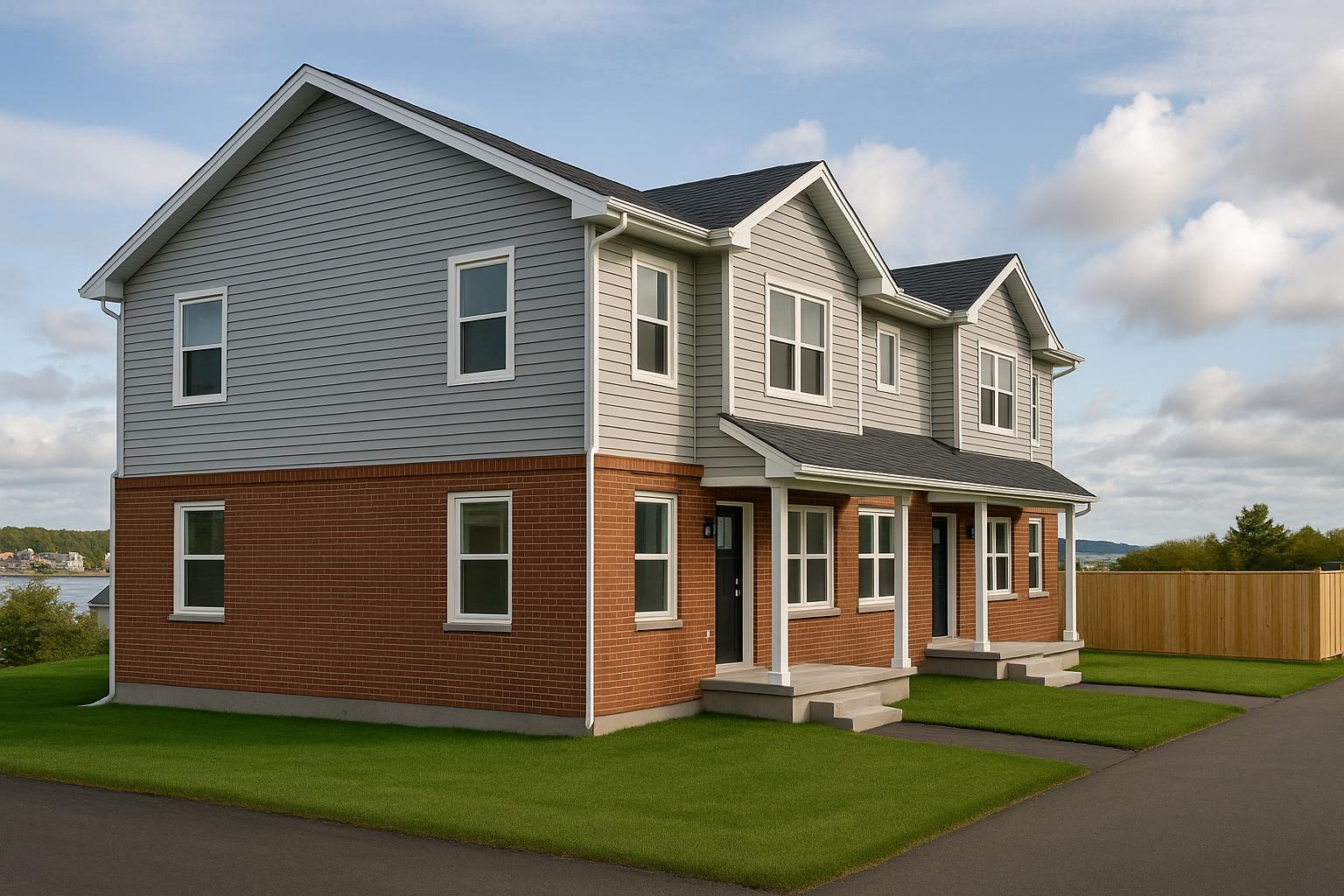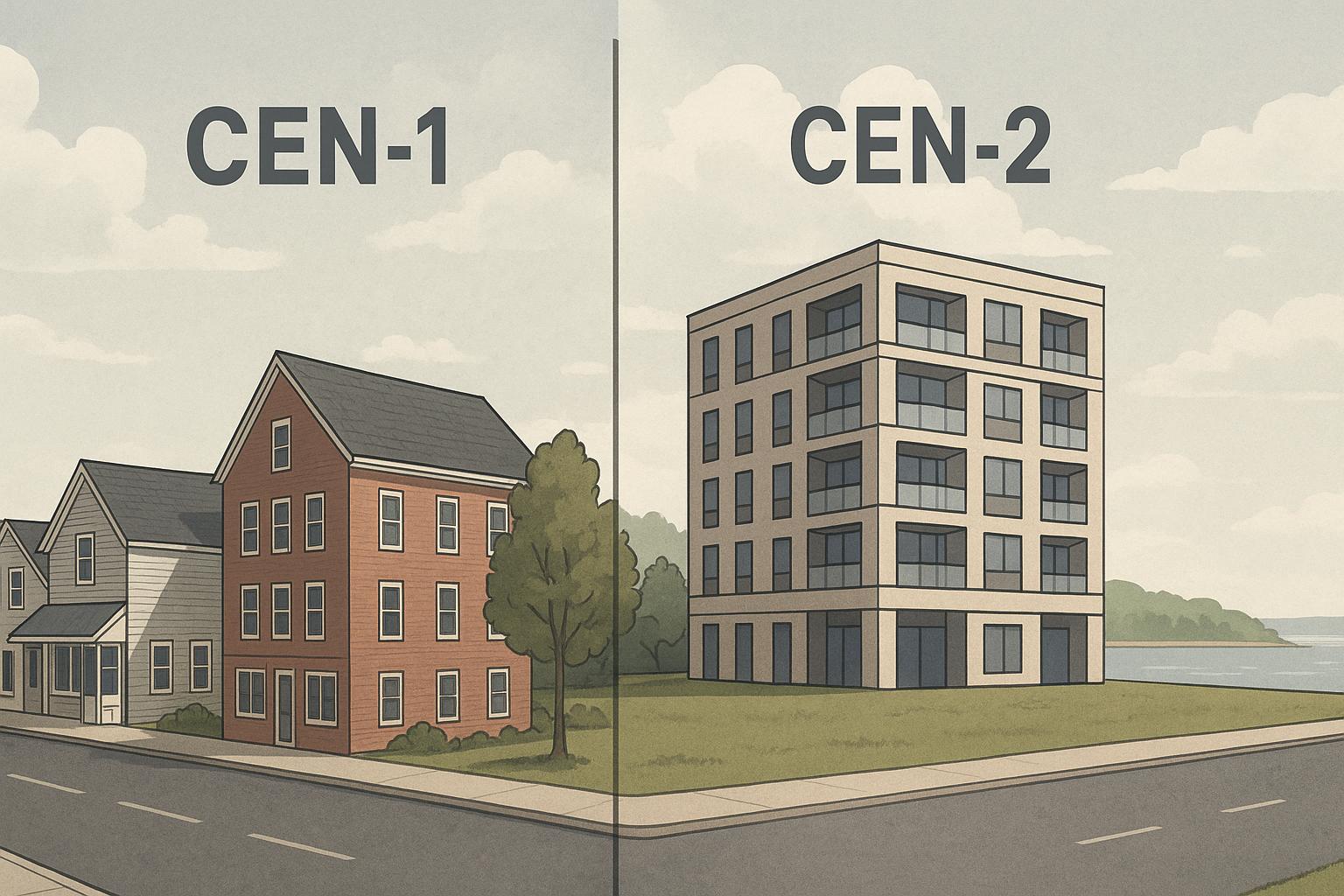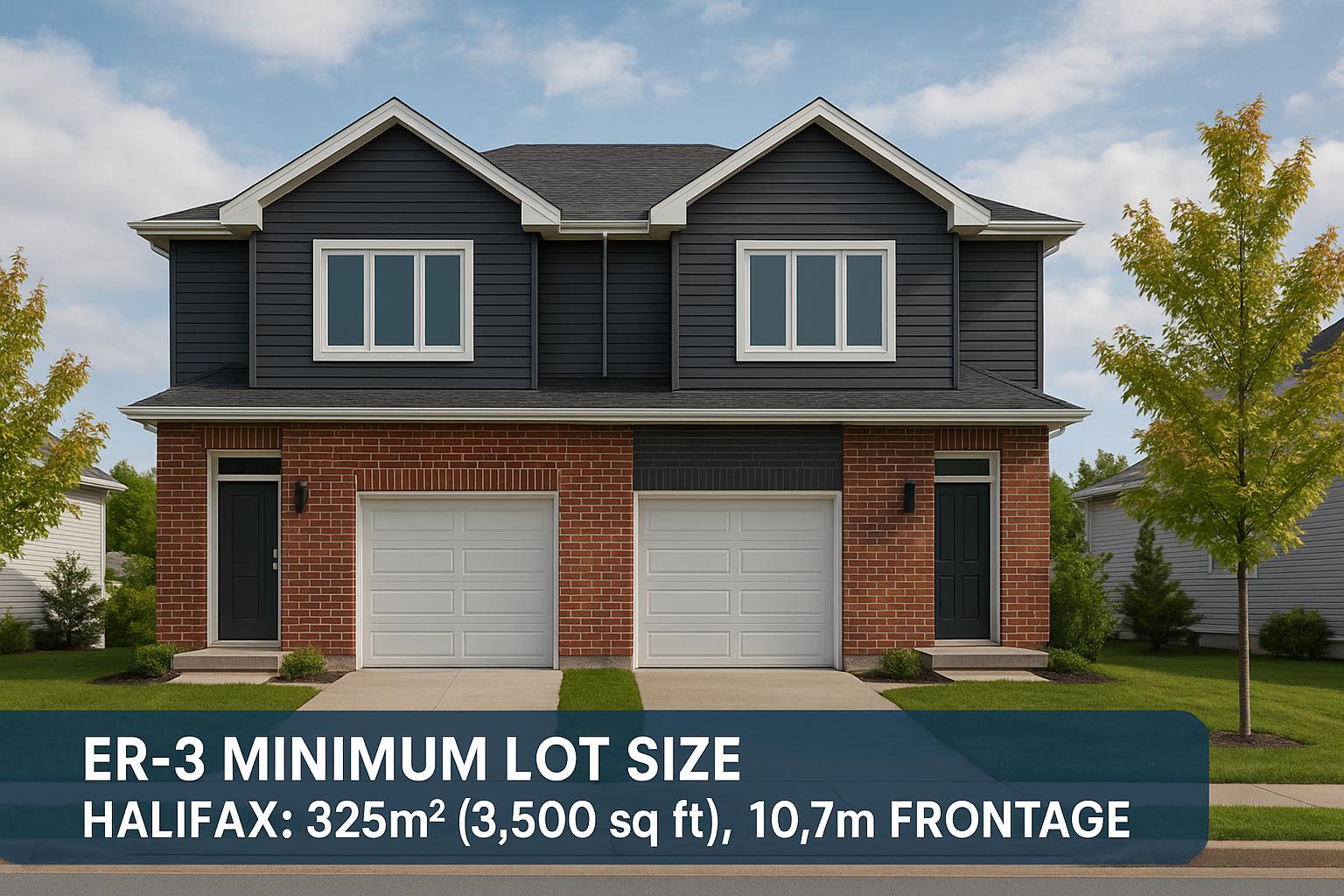Creating quieter, more comfortable multi-unit buildings in Nova Scotia requires careful planning and attention to sound control. The key lies in achieving higher STC (Sound Transmission Class) and IIC (Impact Insulation Class) ratings, which measure how well walls and floors block airborne and impact noise. While building codes require a minimum of STC 50 and IIC 50, aiming for STC/IIC 55-60 significantly reduces noise complaints and improves tenant satisfaction.
Key points to know:
- STC measures airborne noise (e.g., voices, music). Higher STC means better soundproofing.
- IIC measures impact noise (e.g., footsteps). Higher IIC reduces vibrations.
- Nova Scotia's building code sets minimum STC/IIC at 50 (lab-tested) or 45 (field-tested).
- Exceeding these ratings can attract tenants willing to pay higher rents for quieter spaces.
- Proper sealing, quality materials, and integrated construction processes are critical for success.
For property owners, investing in superior soundproofing early on prevents costly retrofits, increases tenant retention, and boosts property value. Integrated design-build methods ensure consistent results by addressing soundproofing from the start, avoiding gaps caused by fragmented construction approaches.
Maximizing STC & IIC Performance [Webinar]
STC and IIC Ratings: How Sound Control is Measured
Understanding how sound control is measured is key to making smart choices about the acoustic performance of multi-unit buildings. Two primary ratings - STC and IIC - serve as essential benchmarks for soundproofing strategies.
STC and IIC Ratings Explained
Sound Transmission Class (STC) measures how well walls and floors block airborne noise, such as voices, music, or TV sounds [1]. For instance, if a tenant complains about hearing their neighbour’s late-night TV, it’s likely an STC issue.
Impact Isolation Class (IIC), on the other hand, focuses on impact noise - think footsteps, dropped objects, or furniture being moved [1]. A common example is when someone can hear footsteps from the unit above.
Both ratings use a numerical scale, where higher numbers indicate better soundproofing. In North America, building codes for multi-family dwellings generally require a minimum of 50 STC and 50 IIC, with field-tested measurements not falling below 45 FSTC or 45 FIIC [1].
The two ratings work together: STC addresses airborne noise, while IIC tackles vibrations that travel through the structure. Different materials and methods target each rating. For example:
- To improve STC: Use wall insulation or double layers of drywall.
- To improve IIC: Install flooring underlayments or resilient channels [1].
Products like Quiet Qurl, a sound control mat, can enhance IIC ratings by adding three to five points [2]. These measurements help guide material choices to achieve better acoustic comfort.
Why Single-Number Ratings Don't Tell the Whole Story
While STC and IIC ratings offer helpful benchmarks, they don’t capture the full picture. Real-world sound performance depends on more than just numbers. Factors like installation quality and attention to detail play a huge role in achieving the desired level of sound control. So, while these ratings are a good starting point, they’re only part of the equation when it comes to creating a quieter, more comfortable living environment.
Nova Scotia Building Code Requirements for Sound Control
In Nova Scotia, the National Building Code establishes the baseline acoustic standards for multi-unit residential buildings. While meeting these standards is mandatory, going beyond them can result in fewer noise complaints and happier tenants. Below, we break down the required ratings and assembly specifications outlined in the code.
Minimum STC and IIC Standards for Multi-Unit Buildings
The building code outlines specific sound transmission targets for walls and floors in multi-unit buildings. Wall and floor assemblies between dwelling units must achieve STC 50 and IIC 50 ratings in laboratory conditions. However, real-world testing often results in slightly lower ratings, with FSTC 45 and FIIC 45 being acceptable.
Certain areas, like elevator shafts, mechanical rooms, and garbage chute walls, require stricter soundproofing due to their higher noise levels. These walls must meet STC 55 ratings to limit noise transfer to adjacent dwelling units. Similarly, party walls and stairwell walls are required to meet STC 50 ratings, ensuring effective sound isolation regardless of the construction materials used.
While these are the minimum requirements, areas prone to higher noise - such as elevators and garbage chutes - benefit from enhanced soundproofing to improve overall acoustic performance.
Exceeding Code Minimums for Superior Acoustic Comfort
Meeting the basic STC 50 and IIC 50 standards might satisfy legal requirements, but it often falls short of creating a truly peaceful living environment. Property owners looking to elevate tenant satisfaction should aim for STC 55-60 and IIC 55-60 ratings, which significantly reduce noise transmission between units.
For example, an STC 50 wall allows murmured conversations to be audible, while an STC 55 wall blocks most speech entirely. This improvement directly translates into fewer noise complaints and greater tenant retention.
Higher IIC ratings also make a noticeable difference, especially for impact noise like footsteps or dropped objects. Floors with IIC 50 ratings still transmit these sounds, but upgrading to IIC 55-60 reduces such disturbances, which is particularly valuable in buildings where families with children occupy upper floors.
Exceeding the minimum standards also offers a competitive edge in the rental market. Properties that advertise superior sound control can attract tenants willing to pay higher rents for a quieter, more comfortable living environment. Although enhanced acoustic assemblies cost an additional $2–$4 per square foot, they often lead to higher tenant retention and justify premium rental pricing.
For most small multi-unit properties in Nova Scotia, targeting STC 60 and IIC 60 ratings strikes the perfect balance between acoustic comfort and cost-effectiveness. Achieving ratings beyond 60 typically involves more complex and expensive construction methods, making it less practical for most projects.
Construction Methods and Materials for Sound Control
Achieving effective sound control comes down to using the right materials and paying close attention to how they’re installed. Even walls and floors with high STC/IIC ratings can fail if the installation isn’t done with precision. Small gaps, penetrations, or weak spots around the edges can allow sound to sneak through, undermining the entire system. Here’s a breakdown of essential sealing techniques to block sound leaks.
Proper Sealing and Installation Details
Unsealed gaps and penetrations are the enemy of good soundproofing. To maintain acoustic integrity, all gaps - whether at framing edges, electrical outlets, plumbing, or HVAC penetrations - should be sealed using high-quality acoustic caulk. This step is crucial to reduce flanking transmission, which happens when sound bypasses the main barrier by travelling through adjacent materials.
For electrical outlets, offset back-to-back boxes and seal them with acoustic putty. Plumbing and HVAC penetrations should be treated with flexible boot connections or wrapped in acoustic materials to prevent sound from slipping through.
Doors and windows are common weak spots. Opt for solid-core doors paired with weatherstripping and acoustic seals. These measures are especially critical for units facing corridors, where noise levels can be higher. Lastly, consider third-party acoustic testing to confirm that all sealing and installation measures are effective and ensure long-term sound performance.
sbb-itb-16b8a48
Integrated Design-Build vs. Fragmented Construction Approaches
Sound control is a key factor in keeping tenants happy and maintaining property value. In multi-unit buildings, how you approach construction plays a big role in achieving effective acoustic performance. With fragmented construction, responsibilities are split among multiple contractors. Each contractor focuses solely on their specific task, often overlooking the bigger picture of sound control. This disjointed approach can lead to gaps in accountability, which ultimately impacts how well the building handles noise.
On the other hand, integrated design-build keeps everything under one roof, from design to construction. This approach ensures that acoustic requirements are baked into the project from the start. A single team manages both the planning and installation of sound control measures, reducing the risk of miscommunication and ensuring a consistent focus on performance.
One Team, One Responsibility for Sound Control
The biggest advantage of an integrated design-build model is clear accountability. In fragmented construction, resolving acoustic issues can become a blame game between contractors. But with an integrated team, the same group is responsible for the project’s sound performance from start to finish. If sound transmission doesn’t meet acceptable levels, the team that designed and built the system is the one responsible for fixing it - no finger-pointing involved.
This accountability begins in the design phase. When designers, engineers, and construction professionals collaborate from the outset, potential sound control challenges can be flagged early. Together, they find solutions that balance performance with practical construction methods. This teamwork not only prevents disputes between trades but also makes adjustments easier and often more cost-efficient.
Working as a unified team also ensures critical details - like proper sealing and consistent material application - are handled with care. These details are essential for achieving superior acoustic performance, and the integrated approach helps ensure they don’t fall through the cracks.
Fixed Pricing and Guaranteed Timelines
Another major benefit of the integrated design-build model is the ability to lock in pricing and timelines. Unlike fragmented construction, where costs can balloon due to unexpected changes, integrated teams can offer guaranteed maximum pricing much earlier - sometimes when the design is only about one-third complete. Because the same team handles both the design and the build, they can accurately predict costs and ensure that all acoustic requirements are factored into the budget from the start. This eliminates the uncertainty of competitive bidding and reduces the risk of costly change orders.
This pricing certainty is especially important for projects that require premium materials and specialized techniques for sound control. Plus, with design and construction happening in tandem, work can begin when the design is only 30–40% finished. This streamlined process shortens the overall project timeline, allowing property owners to start earning rental income sooner. For example, in Nova Scotia, quality two-bedroom units typically rent for $1,950 to $2,100 per month, making an earlier completion financially advantageous.
Integrated teams also take on the risk of delays. If acoustic testing later reveals issues, the same team that installed the system is responsible for fixing them promptly. This avoids the coordination headaches that often arise when multiple contractors are involved in resolving problems.
Beyond individual projects, the integrated approach fosters continuous improvement. Teams can carry forward lessons learned - refining wall assemblies, improving installation techniques, and enhancing overall sound control on future builds. This systematic feedback loop is a far cry from the fragmented approach, where individual trades often work in isolation, leaving tenant satisfaction to chance rather than careful planning.
Quality Control and Long-Term Performance
Ensuring effective sound control and maintaining it over the years requires a commitment to thorough quality assurance and consistent upkeep. Even the most well-designed acoustic systems can falter without proper care, leading to tenant dissatisfaction and a potential drop in property value.
What sets a reliable construction process apart from a more haphazard approach is how quality control is embedded into the workflow. Traditional methods often rely on basic visual checks and compliance reviews, which can miss critical details. Achieving dependable sound control, however, demands more precise verification techniques. This section explores objective testing methods and the scheduled maintenance required to preserve acoustic performance.
Third-Party Testing and Verification
Independent testing is essential for ensuring the long-term reliability of sound control systems. By measuring how sound travels between units in real-world conditions, third-party acoustic testing validates whether the system is performing as intended.
Testing typically occurs at two key stages: during construction and after project completion. Testing during construction allows teams to catch and correct issues early, saving time and money by addressing problems before walls are sealed and units are occupied. Post-completion testing, on the other hand, ensures the entire acoustic system functions cohesively. These tests measure both airborne sound transmission (STC ratings) and impact sound transmission (IIC ratings) between units.
The documentation provided by these tests is not only useful for insurance purposes but also adds value during property sales. Additionally, it helps protect property owners from tenant disputes over noise. When objective data confirms that the building meets or exceeds code requirements, it provides evidence that any noise complaints are likely due to tenant behaviour rather than construction flaws.
Specialized testing equipment and trained professionals ensure results meet Nova Scotia’s building standards. If weaknesses in specific frequency ranges are detected, these experts can recommend targeted fixes to enhance overall performance.
Maintenance for Lasting Sound Control
Once the acoustic system has been verified, its effectiveness hinges on a consistent and proactive maintenance plan. Over time, materials can degrade, and gaps may form as buildings settle or expand and contract with seasonal changes. These small issues can significantly impact sound control if left unaddressed.
Key maintenance tasks include inspecting and replacing window seals and reapplying acoustic caulk around penetrations. These steps help prevent tiny gaps that could compromise acoustic performance. Floor systems also require attention - loose floorboards should be secured promptly to reduce impact sound transmission. For more significant improvements, removing floorboards and filling gaps with insulation materials like polystyrene or rock wool can further reduce sound transfer.
Scheduling maintenance alongside regular property inspections or tenant turnover periods is a practical approach. Vacant units provide an ideal opportunity to refresh acoustic seals and address any emerging issues. This proactive strategy helps prevent minor concerns from escalating into major problems.
Property owners who prioritize systematic maintenance often enjoy higher tenant satisfaction and reduced turnover. Quiet, well-maintained units can command premium rents, making the investment in acoustic upkeep worthwhile.
Additionally, keeping detailed records of maintenance activities supports warranties and helps identify potential installation issues early. These insights not only protect current investments but also inform future projects, enabling continual improvement in sound control strategies.
Nova Scotia Conditions and Helio Urban Development's Methods

Nova Scotia's maritime climate presents some unique hurdles when it comes to maintaining effective sound control in multi-unit buildings. The high humidity and frequent temperature changes can cause materials to shift, which may weaken soundproofing measures unless these factors are addressed early in the construction process.
Sound Control Challenges in Nova Scotia
Construction in Nova Scotia often prioritizes structural stability and weatherproofing over acoustic performance. Adding to the complexity, the province's short construction season pushes builders to work on tighter timelines. This rush can lead to installation mistakes, which may compromise sound control in the long run.
Helio's System for Acoustic Performance
To overcome these climate-driven challenges, Helio Urban Development employs a design-build approach that integrates acoustic planning from the very beginning. Their strategy involves assessing room dimensions, surface materials, and building orientation to create soundproofing solutions tailored to Nova Scotia's specific conditions.
Here are some standout aspects of Helio's system:
- Fixed pricing: Units are priced at $160,000 each, featuring acoustic assemblies that exceed minimum code requirements.
- Daily monitoring: The team keeps a close eye on installations, ensuring quality even when weather conditions disrupt schedules.
- Accountability measures: A 6-month construction guarantee includes financial penalties of up to $1,000 per day for delays, ensuring projects stay on track.
Helio also collaborates with acoustic experts to design and implement custom soundproofing strategies. They choose sustainable materials, such as recycled and natural fibres, which not only absorb sound effectively but also hold up well against environmental changes.
To ensure top-notch results, Helio employs triple quality verification. This process includes multiple inspections by professional engineers and even allows property owners to select their final inspector. This meticulous approach ensures that the acoustic systems meet or exceed expectations, regardless of the challenges posed by Nova Scotia's climate. By embedding soundproofing into their integrated design-build process, Helio demonstrates how careful planning and execution can deliver lasting acoustic comfort.
Conclusion: Building Multi‑Units with Proper Sound Control
Creating acoustically comfortable small multi-unit buildings in Nova Scotia isn’t just about meeting basic code requirements. It’s about crafting rental properties that attract higher rents, keep tenants happy, and maintain their value over the long haul.
The construction method plays a huge role in this success. Traditional, piecemeal construction practices often miss the mark on acoustic issues during the early design stages, which can lead to expensive fixes down the road.
This is where a unified construction approach makes all the difference. Integrated design-build methods are increasingly favoured by property owners who prioritize acoustic performance. Top design firms and federal agencies are beginning to rely on these streamlined processes, ensuring that sound control is considered from initial planning right through to occupancy evaluations [3].
From a financial standpoint, tackling sound insulation at the outset is far more cost-effective than retrofitting later. Acoustic remediation can be a pricey endeavour, so investing in proper insulation and materials early on pays off significantly [1].
Nova Scotia’s unique conditions, such as its maritime climate and shorter construction seasons, add another layer of complexity. However, builders using systematic methods - like Helio’s fixed-price construction model at $160,000 per unit with guaranteed timelines - prove that excellent acoustic performance is entirely achievable under these constraints.
By involving acoustical experts right from the start and maintaining single accountability throughout the project, builders can avoid the common pitfalls of fragmented construction. This integrated approach eliminates gaps between what’s planned on paper and what’s executed on-site, a frequent issue with more traditional methods [3][1].
For property owners in Nova Scotia, prioritizing sound control isn’t just good practice - it’s a smart investment. With thoughtful planning, high-quality materials, and a cohesive construction strategy, acoustic comfort becomes a standout feature that adds real value to rental properties for decades to come.
FAQs
Why should property owners in Nova Scotia aim for higher STC and IIC ratings than the minimum building code requirements?
Exceeding the minimum STC (Sound Transmission Class) and IIC (Impact Insulation Class) ratings can make a world of difference in the acoustic comfort of small multi-unit properties. Think quieter living spaces, improved privacy, and happier tenants - all of which lead to fewer turnovers and a stronger appeal for renters.
For property owners, investing in high-quality soundproofing can elevate their units to premium status in a competitive market. This not only boosts long-term property value but also helps retain tenants. By going above and beyond in acoustic performance, landlords can create living spaces that not only meet but often surpass tenant expectations, making their properties even more desirable.
How does a design-build approach enhance soundproofing in small multi-unit buildings compared to traditional construction methods?
A design-build approach simplifies the construction process by bringing design and construction teams together right from the beginning. This early collaboration improves coordination and ensures that soundproofing measures, like achieving ideal STC (Sound Transmission Class) and IIC (Impact Insulation Class) ratings, are factored into the planning stage. Addressing these details early helps avoid expensive adjustments later on.
With tested assemblies, thoughtfully chosen materials, and reliable techniques, design-build teams can create tailored acoustic solutions for small multi-unit buildings. This method also offers property owners a single point of contact, ensuring consistent quality and smoother communication - avoiding the missteps and miscommunication common in traditional construction methods.
What are the best construction techniques and materials for soundproofing small rental units in Nova Scotia’s climate?
To improve soundproofing in small rental units, consider using materials like spray foam insulation, blown-in cellulose insulation, or batt insulation. These options are effective at cutting down noise transmission and come with the added bonus of boosting energy efficiency.
For even better sound control, Insulated Concrete Form (ICF) construction is worth exploring. This method offers excellent noise insulation and durability, making it a solid choice for Nova Scotia’s maritime climate, where weather resilience is key.
Pairing these materials with smart construction techniques can make a noticeable difference in acoustic comfort, creating a quieter and more pleasant living space for tenants.



